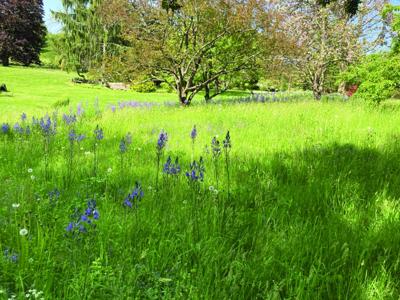Older adults, suggests Jackie Algon of the Wilton Connecticut Pollinator Pathway, can likely remember coming back from summertime drives with insects “splatted” all over the car’s windshield. Younger drivers, however, have almost certainly never experienced that, and for a simple reason: as repeated scientific censuses have revealed, insect populations are crashing all over the world.
That may seem like a welcome development to the insect averse, but consider what we are losing. Approximately 80% of flowering plants are pollinated by animals. Pollination is the process by which a grain of pollen is transferred from the male sexual organ in a flower to a female one, making possible the successful production of seeds and fruits. Birds and bats perform this service for a few plants, but it is insects that do the heavy lifting. In all, about a third of human food is produced with the help of such pollinators. Lose the insect pollinators, Jackie Algon points out, and you not only lose your wildflowers and the plants that produce your garden blossoms, you’ll also go hungry, losing many of the fruits and vegetables you take for granted.
The causes of the insects’ decline are several, but a principal one, adds Jackie, is the fragmentation of habitat. Once upon a time, farms and natural areas connected into a contiguous whole, allowing the free passage of pollinators and other wildlife from one area to another. Suburbanization and development, however, has turned the natural spaces into isolated islands; this habitat fragmentation has led to a decline in wildlife diversity and population sizes in general and of insect pollinators in particular.
Conservation organizations in Fairfield County, Conn. tried appealing to residents about more habitat-conscious land management, but had not met with a vigorous response. However, everyone likes butterflies, as Jackie points out, and members of four conservationist groups — led by Wilton resident Donna Merrill who was inspired by a similar initiative in Oslo, Norway — found that promoting the preservation of such pollinators brought 80 people to a first meeting in 2017 about linking up natural areas with green pathways.
In practice this meant enrolling landowners at intervals of no more than 750 meters (2,460 feet, slightly less than half a mile) to plant their landscapes with native plants that would host pollinators — providing habitat in which to raise their young and nectar- and pollen-bearing flowers for the adults. Success was such that Wilton now has three pathways reaching out from the town center all the way to the township’s outskirts, in addition to many other residences throughout Wilton whose owners just want to ‘bee on it!’ And beyond: neighboring towns took up the cause and began installing their own pathways, so that pollinators and other wildlife can once again wander more or less freely through much of the region.
More than 200 towns, in fact, have followed Wilton’s example, throughout the Northeast and even down into the mid-Atlantic states. Aside from the intrinsic appeal of the idea, Algon suggests that a couple of other factors played a role in this explosive growth. First, that the leadership structure that Wilton modeled was deliberately non-hierarchical, so that the organization remained a grassroots one. Second was Pollinator Pathway Wilton’s recognition that every town has a different style. Some wanted their initiative managed by their Conservation Commission; others included local groups committed to preservation. To suit all these different styles, the website (pollinator-pathway.org) keeps its instructions for pathway makers very simple. Indeed, it advocates just three basic steps for those wishing to participate: include native plants on your property and manage invasive species; • “do not use pesticides and herbicides”; • “rethink your lawn — mow higher and less often; consider reducing lawn size by adding native shrubs, trees, or a mini meadow; leave some bare ground and dead wood for nesting native bees; leave autumn leaves for overwintering eggs and pupae of pollinating insects”
Those who do wish to join the movement will find that the website, pollinator-pathway.org, has lots of helpful advice and links under the heading “Get Involved.” To highlight their commitment, they can order a 6” sign showing their yard is on the Pollinator Pathway. In addition, those seeking information can listen to a conversation with Jackie Algon on Berkshire Botanical Garden’s Growing Greener podcast at thomaschristophergardens.com/podcast. Joining the movement is easy, and collectively, you can have a big impact while making your landscape more colorful, and more lively.
Be-a-Better-Gardener is a community service of Berkshire Botanical Garden, located in Stockbridge, MA. Its mission, to provide knowledge of gardening and the environment through a diverse range of classes and programs, informs and inspires thousands of students and visitors each year. Thomas Christopher is a volunteer at Berkshire Botanical Garden and is the author or co-author of more than a dozen books, including Nature into Art and The Gardens of Wave Hill (Timber Press, 2019). He is the 2021 Garden Club of America’s National Medalist for Literature, a distinction reserved to recognize those who have left a profound and lasting impact on issues that are most important to the GCA. Tom’s companion broadcast to this column, Growing Greener, streams on WESUFM.org, Pacifica Radio and NPR and is available at his website, https://www.thomaschristophergardens.com/podcast.
Johnson Newspapers 7.1









